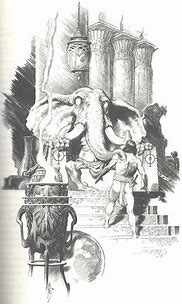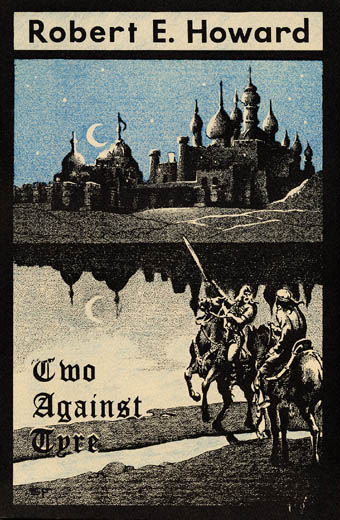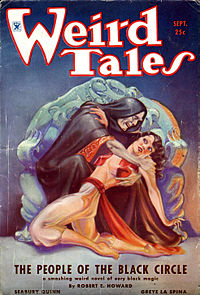robert e howard:
a view
by
antolin gibson
[ + links to podcasts: The Hour of the Dragon - Skulls in the Stars - The Pool of the Black One - The Shadow Kingdom - The Tower of the Elephant and The Tower of the Elephant - Revisited -
The God in the Bowl - Beyond the Black River - Rogues in the House - The City of Skulls -
The Mirrors of Tuzun Thune - The Sowers of the Thunder - The Valley of the Worm -
The Frost Giant's Daughter - Red Nails ]
Here's another piece from the author of Out of the Silent Planet Overview and The Worlds of Edgar Rice Burroughs...this time focused upon colourful planet Earth...
I wonder if there has ever been an action-writer as flowing and many-dimensioned as Robert E. Howard! Most action-adventure in literature, from Homer to Tolkien, involves some formulaic writing which, if used judiciously, is an asset of poetic value, as well as emblematic of a certain kinetic realism – as, it might be, the rhythm of battle, or the spiralling of pursuit, or the sequential progress of an ascent, or descent (Edgar Rice Burroughs a Master of this). But the more one reads Robert E. Howard, the less of a formulaic action-adventure writer he appears. One of the main tools of action-writing - “action-rehash”, at its purest in Batman comics! - is, as it were, spurned by Howard, and he relies on a unique verve, a literary form all of his own.
Which made me curious to find out about this writer, one of the three great stars of “Weird Tales”, a writer who corresponded with H.P.Lovecraft and chided (gently) the latter for his racism; and who died in despair by his own hand in 1936.
As an action-painter with words, Howard uses history as his brimming palette – and while red is the dominant colour, others are used with – on occasion – poignant and poetic sensitivity. Historical movements and peoples are stirred into the exuberant palette, and sprinkled and splurged onto the page. The Picts, the Crusaders, the Janissaries, the Tartars – they are at the command of this obsessive choreographer.
In the four loosely connected “historical” stories - “The Lion of Tiberias”, “The Sowers of the Thunder”, “Lord of Samarcand”, and “The Shadow of the Vulture”, the setting is the exotic East – moreover, the flash-points where East meets West – Jerusalem, Constantinople and – in one of the most moving sieges in all of fantasy – Vienna in “The Shadow of the Vulture”, perhaps Howard's greatest story.
the tower of the elephant

This great “Conan” story, the first fully developed venture in the series, brings together all the main ingredients of Howard's fantasy-writing. There is the swashbuckling action, the uncanny gift of always describing the action freshly, without the recourse to “heroic” formulae. There are the sudden breathtaking vistas into eons of cosmic realities, living myth, tumults of history, that come to a definitive point in the story's adventure. There are the always excellent delineations of character. There are the convincing – yet boldly conceived – details of the mise-en-scène. And there are the well judged quirks of humour and irony (the rope used to steal the secret of the Elephant's Tower was “woven from the tresses of dead women” which the thief took from their tombs at midnight, and then “steeped in the deadly wine of the upas tree, to give it strength”: there is much to mull over here in the workaday life of a thief!). In spite of the deity in the story having a title with quite a Lovecraftian ring to it (Yag-Kosha), “The Tower of the Elephant” nevertheless has much more of the feel of Clark Ashton Smith – for instance, of his first Hyperborean story, “The Tale of Zatampra Zeiros”. But Howard's tale has an ingredient that Smith's far more ironic treatment cannot contain, and this ingredient – although not lacking in some of Howard's other stories – is hardly typical of the author. And that is, a depth of pathos, as though the swashbuckling thrust had suddenly become a lament, a requiem of innocence, which immeasurably deepens the character of the young Conan. Following the mesmerizing dual with the guardian-spider of the Tower, the story seems entirely turned on its head, with the demonic icon as victim, whose defeat of the evil magician (Yara) is by way of Conan, as the hand of fate.
The way Nemesis befalls the Zamorian magician, Yara, in this story may remind one of what an advantage it is for a writer of fantasy to have such an effusive visual flair. To be plunged headlong into otherness is nearly always preferable to an induction by slow degrees. A more abstract writer such as Tolkien tends to express the facets of his world as states of mind, as much as physical environments – such as Mirkwood, Moria, Lothlorien, Mordor, Rivendell – each of these representing a mental mood, expression, philosophy. The genius of Tolkien, however, manages to achieve both a sensual and an abstract intensity, as does David Lindsay (especially in “A Voyage to Arcturus”). Robert E. Howard is pre-eminent among the “headlong” writers – as well as writing about action, he action-writes, dribbling his words as Jackson Pollock dribbled paint. And so it is that the eerie cosmic setting for Yara's doom in “The Tower of the Elephant” is a tour-de-force of immediacy and quintessence of mystery, the sequence being – really - for the sheer hell of it! This form of writing – and this form of art – is perhaps not good for the psychology of the creator (who knows? Headlong art, headlong life: Hemingway, Pollock, Howard?) but, it might be, stretches a light farthest into the darkest corners. Is this true of Howard's pseudo-histories as well as his fantasies? I don't think there is much distinction to make: a story such as “The Swords of Shahrazar” is kalaidoscopic and mosaic in feel, with its intent to include as many elements of factual history as possible, but only thereby to create a fantasy. The interesting varieties of mood in Howard's work are not so much the results of genre-change from fantasy to historical, as from character – say, from Solomon Kane to Conan.
two against tyre

Eithriall, the Gaulish hero of this story, recalls both Conan and Soloman Kane. His innocence – and directness – in asking about a certain religious rite in Tyre, is pure Conan:
“Who is this Thaumuz – some great king of the East?”
A very good question, but one that sparks the fury of the inhabitants of Tyre.
But Eithriall's sardonic brooding is more akin to Solomon Kane:
...a man whose life had been spent, not in marble cities or fertile agricultural valleys, but in savage conflict with nature in her wildest form. This fact showed in his strong moody face, in the hard economy of his form.
The story is without a temporal framework, and the perserverance of the Assyrian Empire in a city named “Kalan” shows Howard's happy-go-lucky history-making at its sweetest. Civilizations are rather as daubs of colour to produce an effective background to the raw psychology of action. The timelessness of Howard's stories - stories that juggle historical references, nonetheless, with deadpan gusto – creates a dreamlike quality, giving the bloodiest action a curious innocence, childlike freshness – a note somewhat touched by E.R. Eddison in The Worm Ouroboros.
the people of the black circle

Impossible, of course, for Howard to sentimentalize the grittiness of his material – but it is wonderful to behold how he slips his most tender and delicate touches in, so that there is no disharmony, but rather a credible reality of emotions and reactions below the savagery of raw action. “The People of the Black Circle”, one of Howard's finest “Conan” tales, follows the adventures of Conan and the princess (Devi) Yasmina of Vendhya; and the adventures of Khemsa, sorceror and renegade of the Black Seers of Yimsha, and the servant girl Gitara. The Devi Yasmina must change her clothes, from those of a princess to those of a common hill-woman of Khurum. Conan and the Devi wait to ambush a girl, but the Devi has a sudden misgiving, and a suspicion of Conan's methods:
“You will not - not kill her?”
“I don't kill women ordinarily,” he grunted, “though some of these hillwomen are she-wolves. No,” he grinned as at a huge jest. “By Crom, I'll pay for her clothes!”
And Conan, after the Devi has changed:
“By Crom!” said he. “In those smoky, mystic robes you were aloof and cold and far off as a star! Now you are a woman of warm flesh and blood! You went behind that rock as the Devi of Vendhya; you came out as a hill girl -”
The love of the wicked sorceror Khemsa for the wicket servant-girl Gitara holds all the poignancy and longing of which Howard is capable, as Khemsa must break off his concentrated defence against the Black Seers in order to come to Gitara's aid:
“Irresistably impelled, she tore herself from her lover's arms before he realized what was happening. Then a hideous thing came to pass. She began to back toward the precipice, facing her tormentors, her eyes wide and blank as dark gleaming glass from behind which a lamp has been blown out. Khemsa groaned and staggered towards her, falling into the trap set for him. A divided mind could not maintain the unequal battle. He was beaten, a straw in their hands. The girl went backward, walking like an automaton, and Khemsa reeled drunkenly after her, hands vainly outstretched, groaning, slobbering in his pain, his feet moving heavily like dead things.”
Notable too, in this story, is the Master of Yimsha's humbling of Yasmina's pride:
“You shall travel back through the lost ages, and view all the shapes that have been you.”
And what follows is an example of Howard's headlong instinctual flair for historical ages – historical flux – as Yasmina journeys back through a series of incarnations:
“She saw walled cities burst into flame, and fled screaming before the slayers. She reeled naked and bleeding over burning sands, dragged at the slaver's stirrup, and she knew the grip of hot, fierce hands on her writhing flesh, the shame and agony of brutal lust. She screamed under the bite of the lash, and moaned on the rack; mad with terror she fought against the hands that forced her head inexorably down on the bloody block.
“She knew the agonies of childbirth, and the bitterness of love betrayed. She suffered all the woes and wrongs and brutalities that man has inflicted on woman throughout the eons; and she endured all the spite and malice of woman for woman . . .”
I think that perhaps no other writer could have brought so well such-like material – with this perspective – at this pace – with this depth – suffused with this colour – and trembling with this passion – as could Robert E. Howard, with such naturalness and verve, the whole psychology and poetry of action.
>> Authors











































